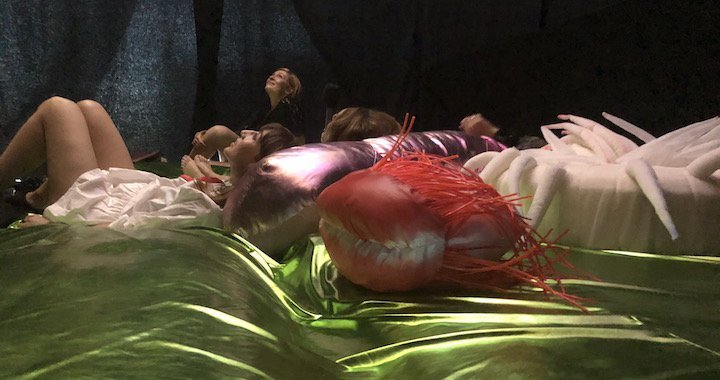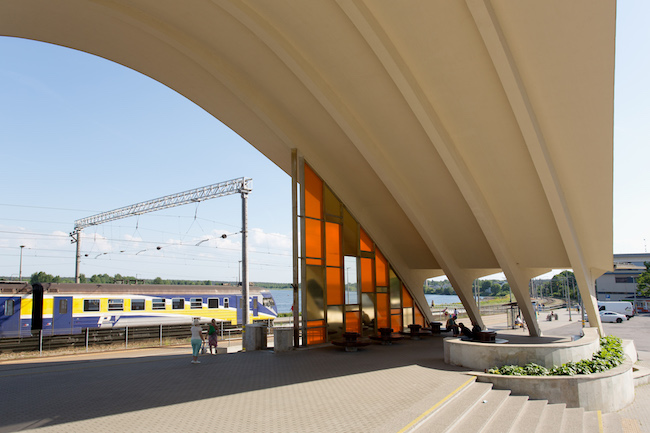
Getting on a train to go meditate
Regarding the Riga International Biennial of Contemporary Art exhibition at Dubulti Art Station
13/08/2018
The Sensorijs (Sensorium) exhibition of the first Riga International Biennial of Contemporary Art, installed at Dubulti Art Station, can take pride in having, possibly, the best defined and most understandable exhibition description. While elsewhere one is sometimes forced to pay for the quantity and diversity of the displayed artwork with conceptual uncertainty, here everything is quite clear: the works by five artists (including the scenographer) included in Sensorijs invite viewers to focus on the five senses and the changes that take place in their bodies and minds in reaction to the impulses created by these works of art. At the same time, this “laboratory of the senses” also addresses the interaction between people and the environment by telling stories about how the nebulous, often irreversible chains of our activities lead, through various feedback loops, to changes in our own bodies and perception.
2_VS.jpg)
Sissel Tolaas. beyond SE(A)nse: Smellers Corner (2018). Photo: Vladimir Svetlov
However, despite this successful and relatively consistent unity, after several visits to Dubulti I’ve concluded that a more successful approach to this exhibition consists of perceiving it in two parts and taking into account a few essential differences between its “lower floor” and “upper floor” (I put these terms in quotes because, as far as I know, no one uses them officially, although the space literally does have a first and a second floor). And, purely sequentially, the lower floor is the first one.
The viewer gets hit in the senses right away, having barely stepped inside the station. There’s loud, instrumental music playing and a pungent smell that’s difficult to define. The latter, it turns out, is the work of Norwegian artist Sissel Tolaas, who has placed a number of “sources” throughout the space exuding concentrates of aromas encountered throughout the Baltic Sea region. Likewise – in successful collaboration with Tilman Wendland, the scenographer of the entire exhibition – she has set up a “smellers’ corner” where, on a large map of the world, she has compiled information about the diversity and intensity of aromas found in various parts of the globe. By putting their noses up to special openings in the wall, visitors can actually smell these different aromas. But – and I don’t know whether to blame my nose or some technical glitch – having taken a whiff of two or three samples and concluding that they all smelled the same (and quite awful, at that), I stopped the experiment. Perhaps I was just unlucky. However, Tolaas’ investment in studying the world of smell is very impressive, and its results, which can be seen at both Dubulti and the Faculty of Biology in Riga, are very educational.
Something similar can be said about the two works by Anne Duk Hee Jordan, Ziggy and the Starfish and Changing Sex in Ecology. Although they are no doubt formally works of art, in terms of the research involved in creating them they are closer to high-quality works of popular science. And, of course, this symbiosis of art and research makes them very approachable, because the otherwise boring or unfamiliar information is dressed in an attractive, professionally polished form. For example, Changing Sex in Ecology consists of a large collage of text and images that tell about the amusing sexual habits of marine animals as well as the serious ways in which human actions influence the animals’ hormonal cycles and genetics. Jordan’s own documentary films are shown on two screens and supplement the collage.
Anne Duk Hee Jordan. Ziggy and the Starfish (2016-18), installation view. Photo: Anne Duk Hee Jordan
The so-called icing on the cake on the lower floor is, of course, Jordan’s film Ziggy and the Starfish. Laying aside any didactic educational content, here she uses fine camera work (which rivals the best of BBC programming) to follow some of the most unusual and unknown aspects of the daily and sexual lives of marine animals. But, instead of David Attenborough’s voice, it’s Jordana’s own music that plays in the background. However, the content is only part of the experience. The film is shown on the art space’s ceiling, and visitors must watch it while lying on a huge waterbed that rocks back and forth every time someone new climbs onto it.
_VS.jpg)
Marisa Benjamin. Floristaurant (2016/18), installation view. Photo: Vladimir Svetlov
Finally, artist Marisa Benjamin addresses the sense of taste with her installation Floristaurant, which tells about her own diet of flowers and colours. Although, for obvious and understandable reasons, it is unfortunately impossible to provide a real tasting experience here on a daily basis, Benjamin did share in her experiences and foods at the exhibition’s opening and will do so again in August, when she visits the Central Market in Riga. Meanwhile, at Dubulti, she tells about them via a beautiful collage (again, in collaboration with Wendland) as well as various kitchen gadgets and a video.
It is no coincidence that the artwork on the first floor of Dubulti Art Station is frequently described using the words “educational” and “informative”. In addition to aesthetic joy and other changes in perception, the artwork’s distinctly research-based character truly expands the outlooks of anyone who normally pays little attention to these issues. It is therefore very good that precisely this exhibition resides in perhaps the most inclusionary and accessible of the biennial’s venues – an active railway station that sees a huge variety of people passing through every day, many of whom also spend a bit of time looking at the exhibition if they have a moment or two to spare. Often these are families with children who, having just returned from the beach, lie down on Jordan’s waterbed with languid delight. Dubulti’s unique environment provides an almost ideal vacation scenario for family relaxation this summer: first the sea, then an educational and enriching exhibition. One also cannot deny that attendance is encouraged by the fact that this is the only biennial exhibition that is open every day, free of charge.
But does the impact of the first-floor artwork really enhance the senses and give visitors a different view of their own perceptions? Probably not. Not just because viewing the exhibition before the next train arrives can be a hurried and restless affair, but also because these works of art are too saturated with content and information, the processing of which decreases the ability to focus on perceiving them with the senses. Of course, lying on a waterbed and looking at strange underwater creatures can be a very meditative process (particularly if one arrives at a rare moment when there are no children jumping on the waterbed), but the content of the film makes the mind continue to work at normal, everyday speed. Therefore the artwork on the first floor, although sometimes having a very intense effect on the sense organs, is more likely to make one contemplate the content rather than concentrate on the process of perception as such. Which, of course, does not make the artwork any worse. It simply means that the informative and educational aspect takes the upper hand here.
Viron Erol Vert. Ambereum (2018). Photo: Viron Erol Vert
Which then finally brings us to the place where things are exactly the opposite, namely, the “upper floor” of Dubulti Art Station, where Ambereum by German-Turkish artist Viron Erol Vert can be seen and heard (except by people in wheelchairs, which is not the artist’s fault). In essence, this is a work of interior design in which the art station’s whole upper level, which usually serves merely as a continuation of the exhibition downstairs, has been itself turned into a work of art. Thus, Vert has changed the upstairs into a visually and aurally specific space where one can linger, lie back on a bean bag chair and spend several undisturbed hours.
For the visual theme, Vert selected Latvia’s self-cultivated myth of being the Land of Amber and made the walls, floor and windows of the space glow in various shades of orange and yellow. Mirrors in varying sizes hang along the walls and from the ceiling, and visitors must remove their shoes when entering the space. Although Ambereum is a closed room, the smells from the rest of the exhibition nevertheless seep upwards, giving the air here a fairly sharp smell as well. Slow, atmospheric music by nine different musicians lulls visitors into a meditative state. This, then, is a space for slowing down the consciousness, and the conditions for doing so are particularly benevolent: there are few informational temptations in the monotone-coloured space, the music is gentle and inconspicuous, and the only interesting thing to look at is one’s own reflection in the mirrors. If that seems too frightening, visitors can just lie down in one of the orange chairs, cuddle up under an orange blanket, close their eyes, listen to the music and look only into their own consciousness. Here, no one is bothered or chased away. On one of my visits I spent three hours in Ambereum just dozing, thinking about life, staring at my phone for a little while, and then dozing off again.
In the context of urban spaces, this makes Ambereum quite unique. There aren’t many public spaces, for example, in central Riga, where a person can just meditate, nap and “be with oneself” in broad daylight. Sooner or later the cafés will ask you to leave, and besides, you need to buy something at a café. In a park, it might start to rain. Sleeping on a bench will attract the attention of the police. And yet, I believe that such places are necessary for urban dwellers subject to constant stress and hurry. Now, thanks to the symbiosis between the Dubulti station, the biennial and Vert’s vision, such a place does exist. True, not in Riga, but at least a precedent has been set. And it no longer seems so crazy to imagine a situation in which, at the end of the work day, an office worker, teacher or store clerk does not hurry straight home but instead heads to the nearest railway station and spends half an hour on the train in order to sit undisturbed for a couple of hours in Ambereum. If up until now the main goal of Rigans when going to Dubulti was to enjoy the beach, now it could also be to meditate. Just imagine – going to Dubulti, meditating and then coming back. Of course, this vision gives little hope that precisely Vert’s work will be one of the biennial’s objects to outlive the biennial itself. While it probably will not, hopefully Ambereum will at least serve as inspiration for the creation of similar spaces elsewhere.
Viron Erol Vert. Ambereum (2018). Photo: Viron Erol Vert
And, since we’re talking about the specificity of spaces, I’d like to end by taking a step away from the biennial and emphasising how wonderful it is what’s happened with the Dubulti station in general. The building designed by Igor Javein has always had a certain charm in and of itself. As an island squeezed between the railway, main street and waterway, it’s always busy and full of people, and yet the wind blowing in from across the Lielupe River meadows refreshes the air. And the promise of sun, surf and sand beckons just a few minutes’ walk away, across the street and beyond the pine trees. It seems almost a foregone conclusion that – amidst the vacationing families, loud motors, seagulls and clanking train wheels – the station has also become a home for art, as if filling a gap that would finally make this place whole. In its inclusiveness and approachability, Sensorijs is an exhibition that seems to suit the Dubulti station very well.

Outside of the Dubulti station. Glass coloured by Viron Erol Vert
.JPG)
_VEV.JPG)
2_VEV.JPG)